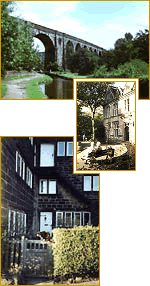Heritage
| Architecture Traditional Saddleworth architecture has a definite character which typifies the area. The original stone buildings scatter the hillsides - the first settlements sit higher up away from the marshy valley bottoms. The earlier buildings used gritstone for the walls and flagstones for the roof. Slate for roofing was not introduced until the mid 19th century, when the construction of the Huddersfield Narrow Canal enabled the large amounts required to be carried in with relative ease. Saddleworth homes often doubled up as textile workplaces and the area contains many examples of weavers' cottages. Workrooms were generally on the top floor, skylighted by long mullioned windows to let in as much light as possible; some houses also retain examples of the ‘takin-in’ steps leading up to first floor doors, designed for the taking in of the raw materials. With the inception of the Industrial Revolution came the commanding presence of the mills and their chimneys. These grew ever larger, reaching four or five storeys. Industrial architecture has set the scene since the 19th century and Saddleworth Viaduct, built in the 1840s for the Huddersfield to Manchester railway, still dominates today. Its skew arches, through which the canal bends, are a prime example of skilled craftsmanship and this scene is often drawn on to epitomise the area. The mid to late 20th century saw some construction which was not in keeping with the character of the area but nowadays, all new developments are pressured to be completed in stone, some drawing on the vernacular architecture in their details. Some mills have also been respectfully converted into residential or business use. |
|
| Home | Saddleworth | Recreation | Community | Business | Organisations | Directory | Contact | Assistance | |||||
|
